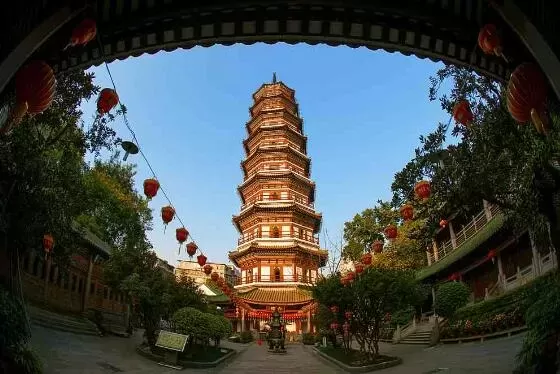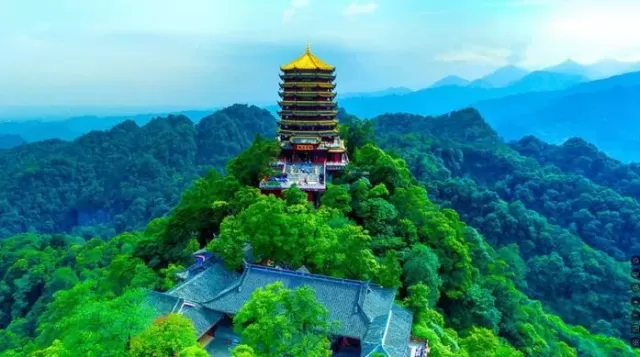Español
Don't miss these Five Unique Temples of China!

China hides architectural treasures among its breathtaking landscapes that are much more than just buildings. They represent the country's cultural legacy through their spirituality. Today, we'll discover five unique temples, each with its own distinct essence, offering an unforgettable experience. Beyond their beauty, we'll tell you what you'll find in each one and how to plan your visit to make the most of it.
1. Temple of Heaven (天坛 - Tiāntán), Beijing

In the heart of modern Beijing rises a vast sanctuary where Ming and Qing emperors once communed with the heavens. The Temple of Heaven, a World Heritage Site, is not an ordinary temple, but rather the world's largest complex of sacrificial altars. Its very design is a lesson in cosmology: the square outer walls and round inner walls symbolize the ancient belief of "Heaven round, Earth square."
What awaits you here?
Prepare to stroll through sprawling, tree-lined parks (especially their iconic ancient cypress trees!) that lead to architectural gems. To the south, the Circular Altar (Huánqiū Tán) , a three-tiered white marble structure where the Emperor offered sacrifices to Heaven. Nearby, the Imperial Vault of Heaven (Huángqióng Yǔ) , with its famous Echo Wall , where a whisper mysteriously travels from one end to the other. Connecting north and south, the awe-inspiring Sacred Elevated Way (Dānbì Qiáo) , a raised causeway that seems to carry you up to the heavens. To the north, the undisputed symbol of Beijing: the Temple of Prayer for Good Harvests (Qínián Diàn) , a circular structure with a triple blue roof on a white marble base—simply majestic. Don't forget to look for the Palace of Abstinence (Zhāigōng) , where the emperor fasted before ceremonies.
Schedule:
Hours vary slightly by season. Generally, the park is open from 6:00 AM to 10:00 PM, but the main attractions (altar, vault, temple) usually close between 5:00 PM and 6:00 PM. Please check specific hours upon arrival!
Recommended Time of Year:
Spring (April-May) and Autumn (September-October). You'll avoid the intense winter cold and the summer heat/rain. Early mornings at any time of year help you avoid the biggest crowds.
How to get there?:
Subway Line 5, Tiantán Dongmen Station (天坛东门) , Exit D (Southwest). Direct to the east gate.
2. Jade Buddha Temple (玉佛寺 - Yùfó Sì), Shanghai

Located in Shanghai, the Jade Buddha Temple is not only an active center of worship, but also the custodian of two extraordinary sculptures that give it its name and worldwide fame.
What awaits you here?
The structure follows the traditional design of a Chinese Buddhist temple. After passing through the imposing Hall of the Heavenly Kings (Tiānwáng Diàn) with its ever-smiling Maitreya Buddha and the guardians of the four directions, you will reach the heart of the temple: the Great Treasury Hall (Dàxióng Bǎodiàn) . Here reside the Three Buddhas (Past, Present, Future) and the Twenty Devas. But the true magnetism lies in the side halls. In the Hall of the Reclining Jade Buddha, you will find the star attraction: the Reclining Buddha (释迦牟尼涅槃像) , carved from a single piece of translucent white jade (96 cm), serenely capturing the moment of Buddha's Parinirvana. In another dedicated room, the Seated Buddha (190 cm), also made of pure white jade and adorned with agate and emerald, radiates a profound peace during his meditation toward enlightenment. The artistry and the quality of the jade are simply breathtaking. A third, larger Reclining Buddha (4 m), brought from Singapore, also resides here.
Schedule:
Generally from 8:00 AM to 4:30 PM. Hours may vary slightly on holidays.
Recommended Time of Year:
Autumn (September-November) and Winter (December-February, avoiding Chinese New Year) are the best times to visit. Shanghai is hot and humid in summer. The temple, being popular, is always busy, but weekday mornings are quieter.
How to get there?:
Bus 19, 206, 316, 328, 738 (Jiāngníng Lù Ānyuǎn Lù stop). Subway Line 13, Jiāngníng Lù (江宁路) station , Exit 4. Walk 5 minutes south.
3. Temple of the Six Banyan Trees (六榕寺 - Liùróng Sì), Guangzhou

The history of this temple is inscribed in a name given by one of China's greatest poets, Su Dongpo. During the Song Dynasty, impressed by six lush banyan trees, he inscribed the characters "六榕" (Six Banyan Trees), which still adorn its entrance. This temple is one of Guangzhou's "Four Great Chan (Zen) Forests," and its main attraction is the pagoda.
What awaits you here?
The atmosphere is more intimate than in the grand complexes of the north. The undisputed star is the Flower Pagoda (花塔 - Huā Tǎ) , a gracefully rising brick tower. Although it appears to have nine stories from the outside, it actually has 17 levels (including "hidden" floors). Its name comes from the original colors, which evoked flowers. Climbing its stairs (be prepared!) rewards you with panoramic views of Guangzhou and a growing sense of peace. Inside, thousands of small Buddha images adorn its niches, hence its other name: the "Pagoda of a Thousand Buddhas." The temple complex, with its courtyards and halls, exudes serenity under the shade of venerable trees.
Schedule:
Generally from 8:00 AM to 4:30 PM.
Entry: Free (a big draw!). Climbing the pagoda may have a small, symbolic fee.
Recommended Season:
Autumn (October-December) and Winter (January-February) are the busiest times of year. Guangzhou is famous for its stifling heat and humidity in spring/summer. Weekdays are less crowded.
How to get there?:
Subway Line 1 or 2, Gongyuan Qian Station (公园前) . Walk about 10-15 minutes to the temple.
4. Mount Qingcheng (青城山 – Qīngchéng Shān), Sichuan

Declared a World Heritage Site along with the Dujiangyan Irrigation System, Mount Qingcheng is one of China's four sacred Taoist mountains. "Qingcheng" means "Green City," a perfect description of its slopes covered in lush vegetation. Here, according to tradition, Zhang Daoling established Taoism in the 2nd century AD. More than just a single temple, it is a spiritual journey along forested paths connecting shrines.
What awaits you here?
The experience is one of immersion in nature and Taoist philosophy. It primarily explores the Anterior Mountain (Qianshan), the most accessible area and richest in temples.
- Jianfu Palace (建福宫 - Jiànfú Gōng): Near the entrance, with its serene atmosphere and famous red lanterns contrasting with the greenery. It houses one of the three pairs of pillars with the third longest pair of verses in China.
- Heavenly Master's Cave (Tiānshī Dòng): The spiritual heart. A temple complex built around a cave where Zhang Daoling is said to have meditated. Here you will see his statue and the impressive thousand-year-old ginkgo tree that, according to legend, he planted himself (spectacular in autumn). It is the headquarters of the Qingcheng Taoist Association.
- Shangqing Palace (上清宫 - Shàngqīng Gōng): Near the top (be prepared for a climb!). It offers magnificent views and a place to rest or enjoy its famous Taoist vegetarian cuisine. The "Sun Viewing Pavilion" (观日亭) provides breathtaking panoramas.
Schedule:
March 1 - November 30: 8:00 AM - 5:00 PM / December 1 - February 28/29: 8:00 AM - 6:00 PM (the cable car and specific temples may close earlier).
Recommended Season:
Summer (June-August) and Autumn (September-October). Summer offers a cool, green refuge from the lowlands (though rain is possible). Autumn showcases the ancient ginkgo in its golden splendor. Avoid national holidays. Weekdays are quieter.
How to get there?:
From Chengdu, take a bus or train to Dujiangyan, then local transport/taxi to the foot of the mountain (main entrance). There are cable cars for part of the ascent.
5. Mogao Grottoes (莫高窟 – Mògāo Kū), Dunhuang

At the crossroads of the ancient Silk Roads, one of humanity's most astonishing artistic and religious treasures emerged from the desert rock: the Mogao Grottoes, a World Heritage Site. They are not an open-air temple, but an immense complex of cave-temple structures carved into a cliff face over a millennium (4th to 14th centuries).

What awaits you here?
It's a unique and carefully curated experience designed to preserve these fragile treasures. You'll visit only a handful of the 492 preserved caves (out of the original 735) on a mandatory guided tour. Inside, you'll be immersed in a universe of Buddhist art : thousands of square meters of dazzling murals depicting sutras, Buddhist legends, daily life, and showcasing the evolution of Chinese art over 1,600 years. You'll see more than 2,000 polychrome sculptures , from small Buddhas to towering figures several meters tall, representing Buddha, bodhisattvas, disciples, and guardian deities. The influence of the cultures that traveled the Silk Road (India, Persia, Central China) is evident in the earliest styles, while the Tang and Song dynasties later left their unique mark. It's a living lesson in history, art, and spirituality. The modern Visitor Center with its exhibits is essential for understanding the context before entering the caves.
Schedule:
April 1 - October 31: 8:00 AM - 6:00 PM / November 1 - March 31: 9:00 AM - 5:30 PM. Advance booking is essential, especially during peak season! Tickets limit the number of daily visitors.
Recommended Time of Year:
Late spring (May) and autumn (September-October). You'll avoid the scorching summer heat in the desert and the bitter cold of winter. Dunhuang is remote, but these times offer the best weather. It's always busy, so booking in advance is key.
How to get there?:
Fly or train to Dunhuang (from Beijing, Xi'an, Lanzhou). From Dunhuang city, take a taxi or tourist bus to the grottoes (about 25 km).
Which one is your favorite?
